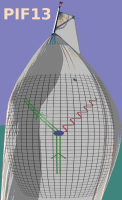Speaker
Dr
Nina Elkina
(Ludwig-Maximilians University of Munich)
Description
The next generation of laser facilities will make possible to
study electron-positron laser plasma arising due to electromagnetic cascades.
The cascade consists of
quantum electrodynamic effects of hard photon
emission and electron-positron pair creation.
A central problem in description of
plasma with quantum electrodynamic effects is the need for a proper model for radiation, which
would simultaneously account for both classical radiation responsible for collective emission and
quantum recoil due to non-coherent hard photons.
The mathematical description of the cascades
boils down
to a system of transport equations for particles distribution function and
the Maxwell equations for electromagnetic fields.
Numerical simulation of these equation in ultra-high intensity regime
involves difficulties arising from broad spectrum of time and space scales simultaneously present in the problem.
The major part of applied computations concerning the kinetic equation is based
on the probabilistic Monte Carlo
methods. However, the stochastic method heavily relies on the use of random sampling of
transport integrals and may lead to noisy and possibly unstable solution of the transport equation.
Alternative highly accurate deterministic methods for the kinetic equations are computationally demanding.
In this context the adaptive grid refinement is advantageous because of electromagnetic cascades are localized at
laser focus.
In this talk, I will review recent advances in the
computational algorithms for QED plasma and discuss open problems.
Author
Dr
Nina Elkina
(Ludwig-Maximilians University of Munich)

